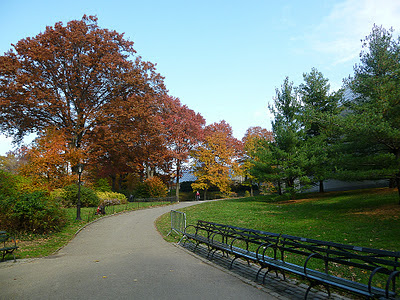But of course I am here to research and network, and that I have been doing. I've met a number of people and have been surprised to discover that the YCBA is bigger than I thought, but they all seem to know one another. I attended a lecture given by visiting senior scholar Clarissa Campell Orr, a well-published historian who is writing a biography about Mary Delany (1700-1788), maker of fascinating paper cut-out botanical collages, about which the YCBA recently did an exhibition. I have a computer work station in the library and have already worked in the Rare Book Room, plus I have access to resources in other libraries on campus. I've also had the opportunity to examine more closely the John Gibson busts in the collection, and they've now actually brought 2 of them out for the public to see, which is great (one of them being the unknown young woman about whom I blogged).
I've been asked to give a presentation on Dec. 16th about my research (yikes!). Fortunately, I've already uncovered some new interesting little tidbits of information, so that should help. For instance, Yale has digitized a travel diary written by Susan Horner (1816-1900). In 1847-48, she accompanied her sister Frances and newlywed brother-in-law Charles (later Sir Charles James Fox Bunbury, 8th Baronet, and Lady Bunbury) on a trip to France and Italy. An artist and historian, Horner later authored books such as Walks in Florence: Churches, Street and Palaces (1877) and Greek Vases: Historical and Descriptive (1897). In the 1850s and 1860s, she carried on a regular correspondence with Gibson and they saw one another socially in London and Rome on future visits, but it appears she first met him while on this trip with her family. Gibson had been living in Rome for 30 years at this time, so he was well-acquainted with everything the city had to offer, and he delighted in acting as a tour guide when it came to art. Ever the classicist, he always looked to ancient Greece and Rome for inspiration. The drawing you see here is but one of many examples of his sketches in which he explored Greco-Roman subjects. The drawing is from the Greek playwright Euripides and shows Antigone Discovered over the Dead Body of Her Brother (image: Royal Academy). I thought it would be interesting to share one of Horner's encounters with Gibson. On this occasion they visited the Vatican Museum, much like you or I have done in the past, traipsing through the same corridors she mentions as well. The only difference then was that there was no electricity, just natural light and maybe gas lanterns or candles for evening visits. Their particular visit together took place on April 10, 1848--exactly 122 years before I was born.
At three we called for Mr Gibson at his studio. He showed us a beautiful drawing he is making, and also some engravings from his works, very well executed; he then accompanied us to the Vatican, where Charles and Frances walked through the Gallery together, and Mr Gibson showed me its wonders. The galleries are very beautiful and very rich, and as we walked along, he stopped me at the most remarkable among its treasures. We entered the Braccio Nuovo which has been added of late years. Mr Gibson pointed out to me the statue of Minerva as the best time of Greek art. ... As Mr Gibson is occupied making a drawing for a bas relief of Hyppolitus, he examined these well, and satisfied himself as to the legitimacy of adding ears or horns to his creatures. I asked him, why it was necessary to confine himself to an imitation of the ancients, to which he replied, that when treating a Greek subject, it ought to be treated as a Greek artist would have conceived it, whereas, in Christian subjects the master is free to use what models he may please. (fol. 51v-52r)















